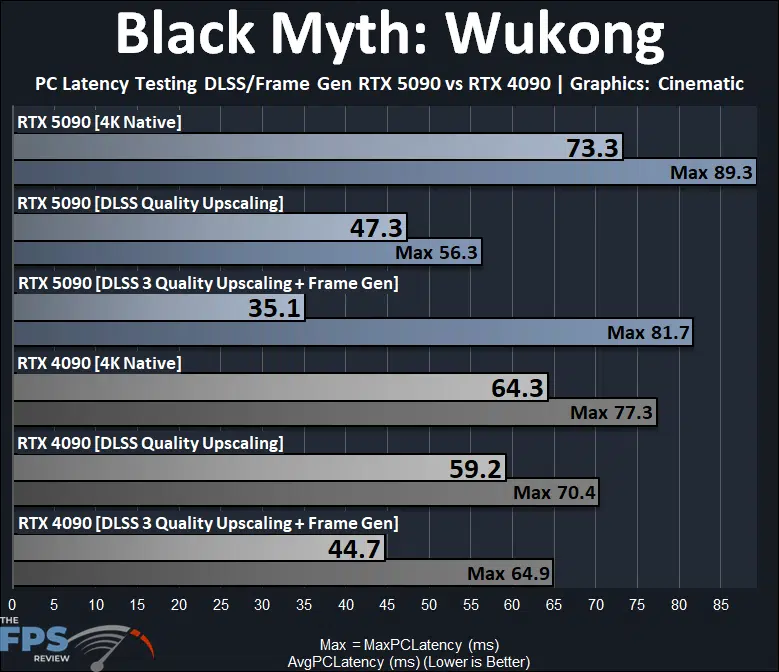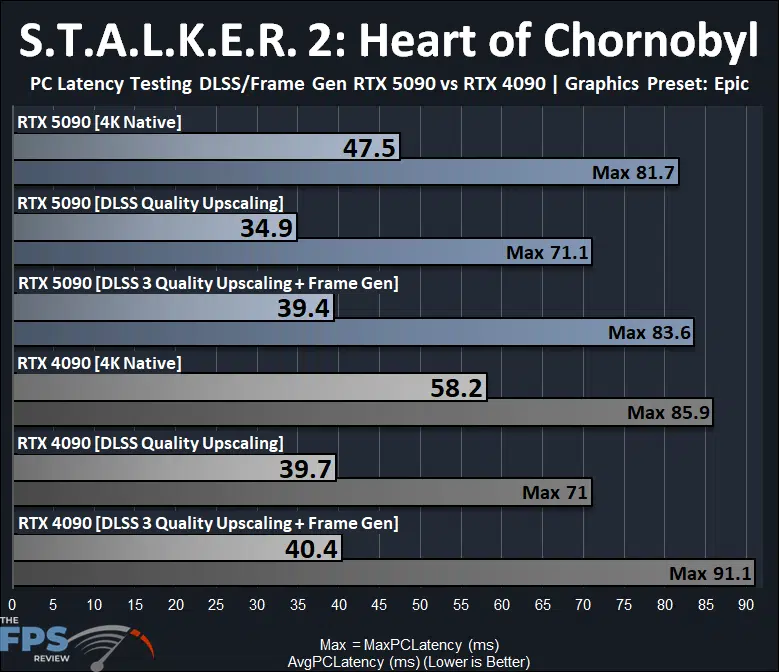Gameplay Performance – 4090 DLSS vs 5090 DLSS Latency
*Take Note* – The performance shown below is not FPS, it is in fact PC Latency represented in milliseconds. We utilized NVIDIA FrameView to capture statistics while playing these games, and are showing the AvgPCLatency and MaxPCLatency results as indicated by NVIDIA FrameView data. For Latency, the lower the number, the better. Therefore, we are showing the MaxPCLatency which shows the highest latency number achieved in the run-through, which would be a “bad” result, you really want the Max Latency to be as low as it can be for the best experience while gaming.
Continuing our latency testing, we thought it’d also be a great idea to do a little comparing between the GeForce RTX 4090’s DLSS latency versus the GeForce RTX 5090’s DLSS latency. We can just simply compare DLSS 3 on both the RTX 4090 and RTX 5090, and see if latency has changed between them on the Upscaling component, and Frame Generation component.
Black Myth: Wukong – 4K

In Black Myth: Wukong we are testing at 4K with Cinematic graphics quality enabled, and are using the built-in benchmark for the test, this makes it very repeatable. Firstly, and most interestingly, it appears that at 4K native resolution the new NVIDIA GeForce RTX 5090 FE actually has higher raster latency than the GeForce RTX 4090 FE. Indeed, the average latency and max latency is higher on the RTX 5090 versus the RTX 4090 at 4K resolution here.
When we enable DLSS Upscaling, well the GeForce RTX 5090 FE drops down the latency quite a bit here, in fact below the GeForce RTX 4090’s Upscaling latency. When we turn on Frame Generation at 4K, the results are even more odd. The average latency of Frame Gen is lower on the GeForce RTX 5090 compared to the GeForce RTX 4090, but the maximum latency is wildly higher on the GeForce RTX 5090 compared to the GeForce RTX 4090. The results here are interesting, to say the least.
S.T.A.L.K.E.R. 2: Heart of Chornobyl

The other new game that we did this test in was Stalker 2, which inherently relies on the CPU quite a bit. In the graph above we are testing at 4K Epic game settings, and using a manual run-through. Unlike Black Myth: Wukong, the latency on the GeForce RTX 5090 is actually lower than the GeForce RTX 4090 at 4K native resolution, it drops the average and maximum latency, which is great to see. When we enable DLSS Upscaling, it’s also very close between the video cards here, the average is a bit lower on the RTX 5090, but the maximum is the same. When we enable Frame Generation, it’s more of the same, the two video cards are actually very close to each other in terms of latency with Frame Generation.
These games definitely show two very different patterns, Black Myth: Wukong is very GPU-oriented, and Stalker 2 is a bit more CPU-driven. Take that for what you will, but it does show that latency is going to be game-dependent, and which card is better or worse is going to depend on the game itself.
